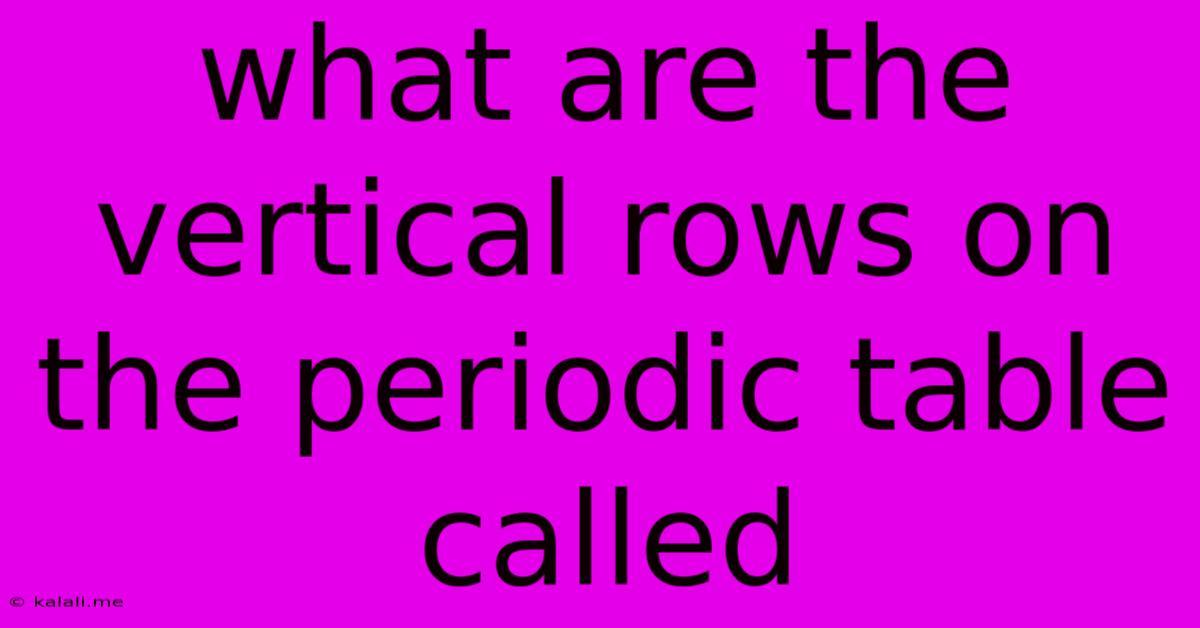What Are The Vertical Rows On The Periodic Table Called
Kalali
Jun 11, 2025 · 3 min read

Table of Contents
What Are the Vertical Rows on the Periodic Table Called? Groups or Families: Understanding the Organization of Elements
The periodic table, a cornerstone of chemistry, organizes elements based on their atomic structure and properties. While the horizontal rows are known as periods, the vertical columns have a slightly more nuanced name: they're called groups or families. This article will delve deeper into understanding the significance of these vertical columns and why they're so crucial to understanding chemical behavior.
Understanding the vertical organization of the periodic table is fundamental to comprehending the relationships between different elements and predicting their properties. The elements within a group share similar chemical characteristics due to having the same number of valence electrons—the electrons in the outermost shell. These valence electrons are directly involved in chemical bonding and reactions, thus determining the element's reactivity and bonding preferences.
Groups vs. Families: What's the Difference?
While the terms "groups" and "families" are often used interchangeably, there's a subtle distinction. Group is the more formal and widely accepted term used in scientific literature and educational settings. Family, on the other hand, is a more informal term sometimes used to highlight the similar chemical behavior and properties shared by elements within a group. Both terms, however, point to the same vertical arrangement of elements on the periodic table.
Key Characteristics of Elements within the Same Group:
Elements within the same group exhibit striking similarities:
- Similar chemical properties: Their valence electron configuration leads to predictable reactivity patterns. For instance, elements in Group 1 (alkali metals) are highly reactive, readily losing one electron to form +1 ions.
- Similar bonding behavior: They tend to form similar types of chemical bonds (ionic, covalent, metallic) with other elements.
- Gradual trends in physical properties: While the properties aren't identical, there are often predictable trends in properties like melting point, boiling point, atomic radius, and electronegativity as you move down a group. For example, atomic radius generally increases down a group.
- Similar oxidation states: Elements in the same group often exhibit similar oxidation states in their compounds.
Examples of Important Groups:
- Group 1 (Alkali Metals): Lithium (Li), Sodium (Na), Potassium (K), etc. Highly reactive metals.
- Group 2 (Alkaline Earth Metals): Beryllium (Be), Magnesium (Mg), Calcium (Ca), etc. Reactive, but less so than alkali metals.
- Group 17 (Halogens): Fluorine (F), Chlorine (Cl), Bromine (Br), etc. Highly reactive nonmetals.
- Group 18 (Noble Gases): Helium (He), Neon (Ne), Argon (Ar), etc. Inert gases with very low reactivity. This low reactivity is due to their full valence electron shells.
Understanding the groups or families in the periodic table is essential for predicting chemical reactions, understanding the properties of elements and compounds, and building a strong foundation in chemistry. The consistent patterns and trends within these vertical columns provide a framework for making sense of the vast array of elements and their behaviors. This structured arrangement makes the periodic table an indispensable tool for chemists and students alike.
Latest Posts
Latest Posts
-
What Body Of Water Separates Australia And New Zealand
Jun 12, 2025
-
Which Of The Following Disasters Has A Slow Onset
Jun 12, 2025
-
Max Moment For Simply Supported Beam
Jun 12, 2025
-
The Motion Of Earth Around The Sun Is Called
Jun 12, 2025
-
A Positive Ion Is Called A
Jun 12, 2025
Related Post
Thank you for visiting our website which covers about What Are The Vertical Rows On The Periodic Table Called . We hope the information provided has been useful to you. Feel free to contact us if you have any questions or need further assistance. See you next time and don't miss to bookmark.